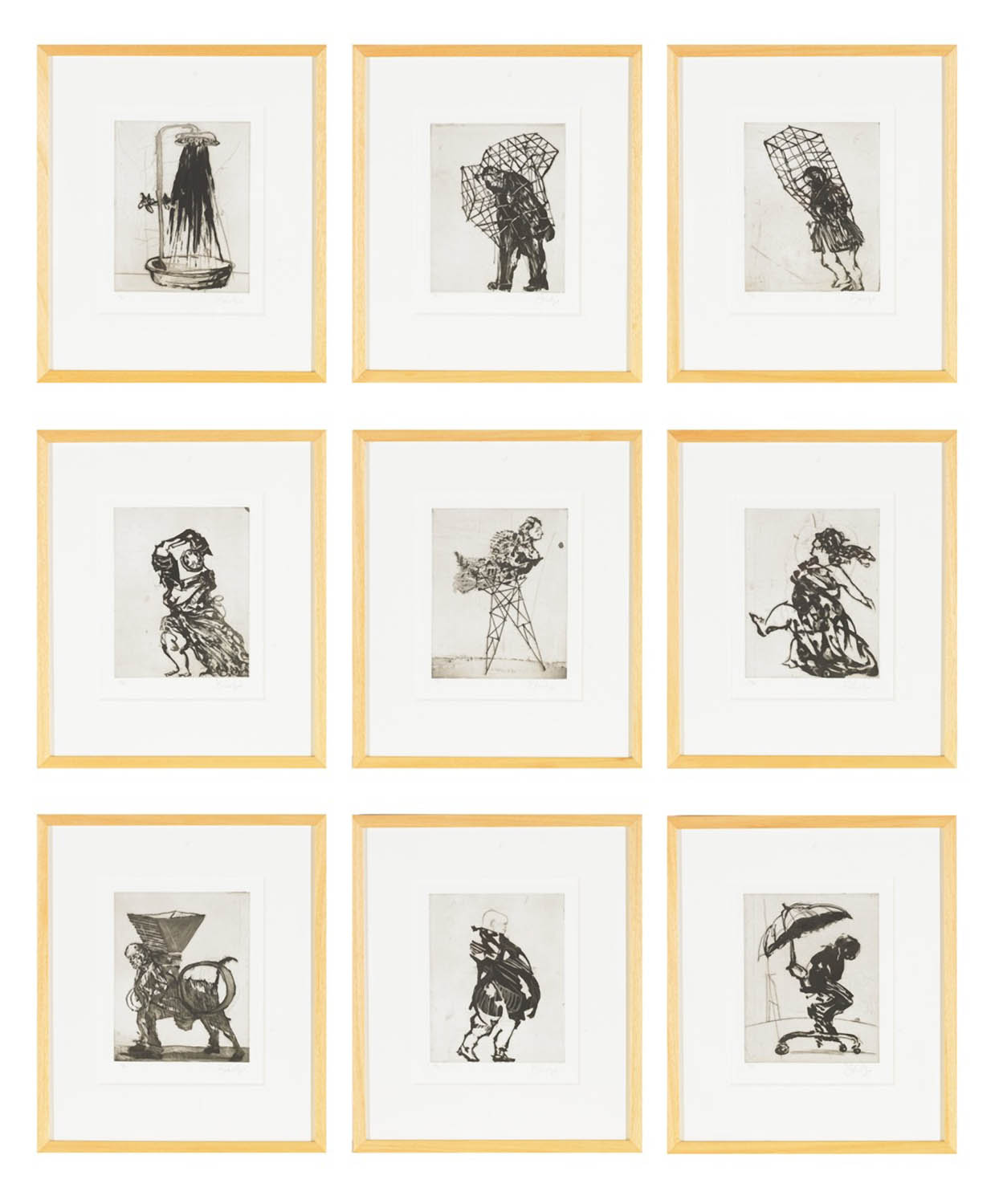William Kentridge
Zeno at 4am, 2001
sugarlift and etching on paper, number 30 from an edition of 40
24.5
x 19.5
cm
each signed 'W Kentridge' (lower right) and numbered (lower left)
SOLD
Provenance
Annandale Galleries, Sydney
Private collection, Sydney
Another from this edition is held in the collection of the Museum of Modern Art, New York
Exhibitions
'William Kentridge, Selected Rare Graphics + Tide Table and Zeno Writing video and installations', Annandale Galleries, Sydney, 21 March – 21 April 2007
In 2002 the South African artist, William Kentridge, was commissioned by 'Documenta XI', to produce and direct 'Zeno at 4 a.m'. Performed by the Handspring Puppet Company and the Duke Quartet, the play was based on ‘The Death of My Father,’ an excerpt from Italo Svevo's 1923 novel 'Confessions of Zeno'.
Set on the eve of the First World War, Zeno is instructed to write his memoirs as a form of therapy. As his life unfolds we see resolutions not carried through, small consoling fictions told repeatedly and a character unable to be understood by his father.
This series of nine sugarlift and drypoint etchings are studies for puppets used in the Zeno production. In the cathartic closing act these pantomime figures were brought to life, simulating a procession of industrial machines. Upright figures with clearly defined torsos, they are depicted going through a series of strange metamorphoses. As Kentridge has said, their curious states are ‘playing with the complex ways we try to structure ourselves as coherent subjects.’

William Kentridge is a South African animator, draughtsman, printmaker and sculptor known for his layered practice of drawing and erasure to create palimpsest-like images. Often using existing pages of text from books or newspaper, Kentridge will draw in pencil, charcoal or ink, creating stop motion animations that, in effect, destroy and replace the previous frame with a new image. His works deliberately leave smudges and other imperfections to reveal the process by which they are made in works that deal with the effects of time, history and the darker aspects of human nature.
Born in Johannesburg, South Africa in 1955, Kentridge studied in South Africa and France and began exhibiting in the 1980s. Descended from Lithuanian Jews who fled Europe during the 1880s pogroms, Kentridge’s parents were anti-apartheid lawyers; his father, Sir Sydney Kentridge, defended Nelson Mandela during the 1956-61 Treason Trials. After a career as an art director on television films and series in the 1980s. From there, he developed his expressionist style to mirror the madness of South African apartheid that shares much in common with Goya’s etchings or the work of the German Expressionists.
For the past decade, Kentridge has created a series of animations, Drawing Lessons, self-interrogations that see him interrogating his own style, references and process: “For anyone who has ever written anything, or drawn anything, or recorded themselves speaking or singing, there’s an enormous difference to one’s sense of self in the moment of making and when you take a step back to become the viewer. As you’re writing, every sentence feels fine. When you’re drawing every line seems necessary. When you’re singing, it sounds great. And when you step back, you are always disappointed.” (William Kentridge, Cristina Ruiz and Ben Luke, ‘Interview: William Kentridge on his life lessons,’ The Art Newspaper, 12 June 2019.)
Kentridge has made 17 animated films, some of which were shown at the 2004 Cannes Film Festival. He has had major solo shows around the world, including at the Metropolitan Museum of Art, New York, USA (2014, 2013 and 2004); the Louvre, Paris (2010); and the Museum of Modern Art, New York, USA (2010 and 1999). In 2015, the National Gallery of Australia, Canberra, held William Kentridge: Drawn from Africa, which toured nationally to the Ian Potter Museum of Art, Melbourne, Ballarat Art Gallery, Ballarat, and the Queen Victoria Museum and Art Gallery, Launceston (2016). His most recent major Australian exhibition at a public gallery was William Kentridge: that which we do not remember, Art Gallery of New South Wales, Sydney (2018-19).